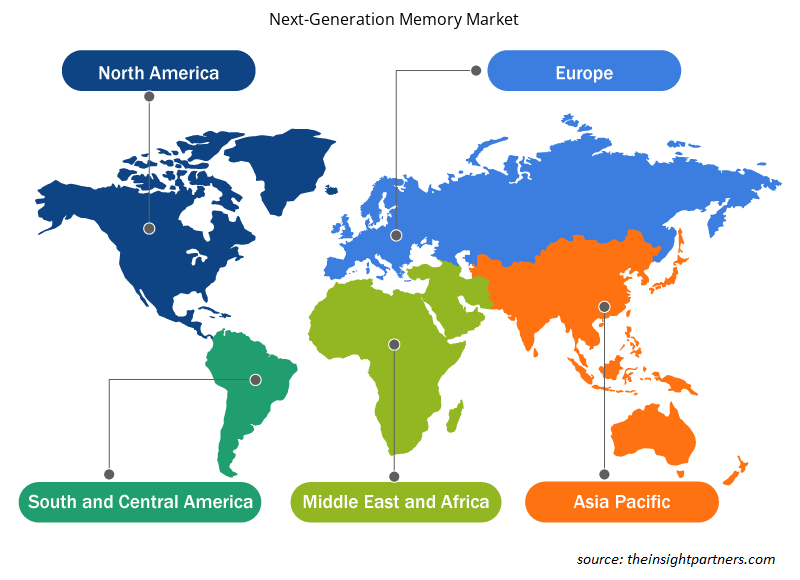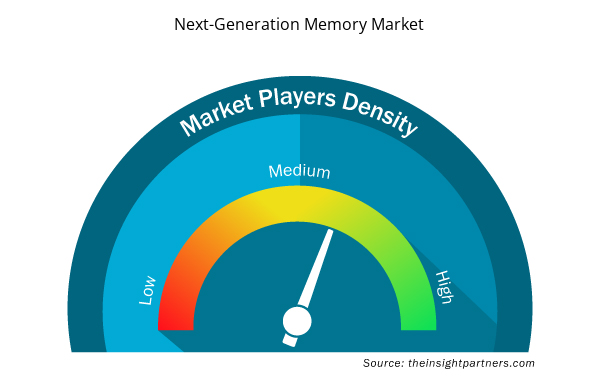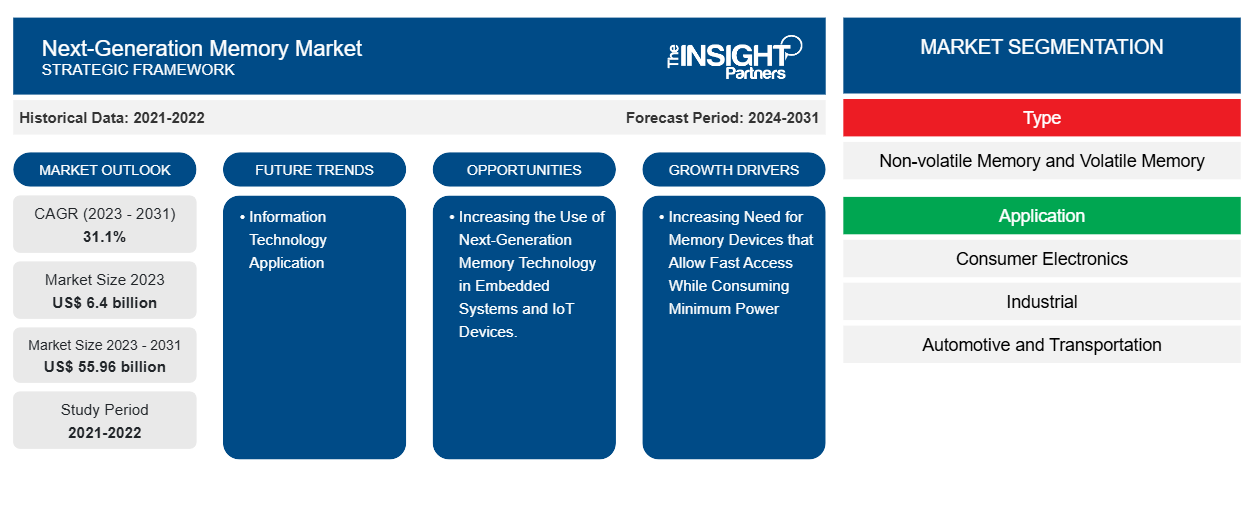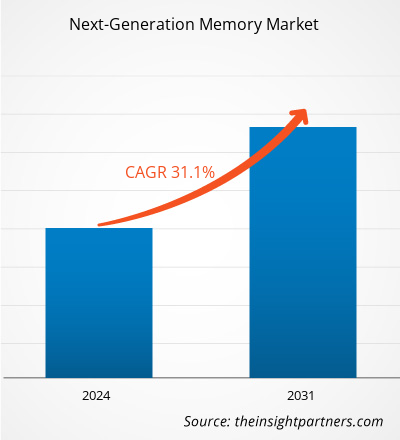次世代メモリ市場規模は、2023年の64億米ドルから2031年には559.6億米ドルに達すると予測されています。市場は2023年から2031年にかけて31.1%のCAGRを記録すると予想されています。次世代メモリ市場は、高速アクセスと低消費電力の需要の高まり、およびエンタープライズストレージ、スマートフォン、スマートウェアラブルでの採用の増加により拡大しています。
次世代メモリ市場分析
機械学習(ML)、人工知能(AI)、モノのインターネット(IoT)、ビッグデータなどの新興技術により、高帯域幅、スケーラビリティ、低消費電力を備えたメモリデバイスの需要が高まっています。これは、ビジネスストレージの需要増加と相まって、市場の成長を牽引する主な要因の1つです。
次世代メモリ市場の概要
次世代メモリは、現在開発中の最先端のコンピュータメモリテクノロジの一種です。これらの進歩により、DRAM や NAND フラッシュなどの従来のメモリ タイプの制約が克服されます。主な目標は、速度、耐久性、エネルギー効率、ストレージ容量など、ビジネス パフォーマンスに不可欠な側面を大幅に改善することです。これらのテクノロジにより、データ密度が向上することが多く、企業はより小さな物理的フットプリントにより多くの情報を保存できます。これらの高度なテクノロジを採用すると、今日のデータ主導の業界では極めて重要な、より高速で効率的なデータ処理が可能になり、企業は競争上の優位性を獲得できます。
要件に合わせてレポートをカスタマイズする
このレポートの一部、国レベルの分析、Excelデータパックなど、あらゆるレポートを無料でカスタマイズできます。また、スタートアップや大学向けのお得なオファーや割引もご利用いただけます。
- このレポートの主要な市場動向を入手してください。この無料サンプルには、市場動向から見積もりや予測に至るまでのデータ分析が含まれます。
次世代メモリ市場の推進要因と機会
市場を有利にするために、消費電力を最小限に抑えながら高速アクセスを可能にするメモリデバイスのニーズが高まっています。
企業が生成するデータが増え、クラウド ストレージが使用されるようになると、大容量で高速ストレージのメモリに対する需要が高まっています。製品性能の向上が半導体部門を前進させています。RRAM、MRAM、FeRAM、NRAM などの新しい不揮発性メモリ技術は、従来の技術よりも高い拡張性、密度、速度、耐久性を提供し、高速性、低消費電力、拡張性に対する需要を満たしています。新しいメモリ技術は、コマンド要件を満たすために通常 1 ~ 10 ns の応答時間を備えています。スイッチング時間とは、コマンド後にメモリが指定された要件を満たすのにかかる時間を指します。
組み込みシステムや IoT デバイスにおける次世代メモリ技術の使用が増加。
組み込みシステムにおける次世代メモリ技術の採用の増加。従来のメモリを次世代メモリに置き換える動きが進むことで、業界関係者に大きなチャンスが生まれます。MRAM と ReRAM は、読み取り速度が高く、消費電力が低く、書き込み速度が速く、不揮発性であるため、組み込みシステムや IoT デバイスに最適です。これらのメモリは、スマート デバイスのインスタント オン機能、エネルギー効率、データ保持を改善できます。これらのメモリは、劣化することなく、多数の読み取りおよび書き込みサイクルに耐えることができます。この機能は、信頼性と寿命を維持するために定期的なデータ更新を必要とする IoT および組み込みデバイスにとって非常に重要です。MRAM や ReRAM などの次世代メモリ技術は、低レイテンシと高速アクセスを提供し、メモリ内計算を可能にします。
次世代メモリ市場レポートのセグメンテーション分析
次世代メモリ市場分析の導出に貢献した主要なセグメントは、タイプとアプリケーションです。
- 次世代メモリ市場は、種類によって不揮発性メモリと揮発性メモリに分けられます。
- アプリケーション別に見ると、市場は、民生用電子機器、産業、自動車および輸送、エンタープライズ ストレージ、軍事および航空宇宙、ヘルスケア、IT および通信、その他に分類されます。
地域別次世代メモリ市場シェア分析
次世代メモリ市場レポートの地理的範囲は、主に北米、アジア太平洋、ヨーロッパ、中東およびアフリカ、南米/中南米の 5 つの地域に分かれています。北米地域は、次世代の技術とインフラストラクチャの早期ユーザーです。情報技術業界は米国経済に大きく貢献しています。急速に進化する技術と企業全体でのデータ生成の増加により、より効率的な処理ソリューションが必要になります。これらの変数が、次世代メモリ市場に対する地域の需要を促進します。
次世代メモリ市場の地域別分析
予測期間を通じて次世代メモリ市場に影響を与える地域的な傾向と要因は、Insight Partners のアナリストによって徹底的に説明されています。このセクションでは、北米、ヨーロッパ、アジア太平洋、中東およびアフリカ、南米および中米にわたる次世代メモリ市場のセグメントと地理についても説明します。

- 次世代メモリ市場の地域別データを入手
次世代メモリ市場レポートの範囲
| レポート属性 | 詳細 |
|---|---|
| 2023年の市場規模 | 64億米ドル |
| 2031年までの市場規模 | 559.6億米ドル |
| 世界のCAGR(2023年~2031年) | 31.1% |
| 履歴データ | 2021-2022 |
| 予測期間 | 2024-2031 |
| 対象セグメント | タイプ別
|
| 対象地域と国 | 北米
|
| 市場リーダーと主要企業プロフィール |
|
次世代メモリ市場のプレーヤー密度:ビジネスダイナミクスへの影響を理解する
次世代メモリ市場は、消費者の嗜好の変化、技術の進歩、製品の利点に対する認識の高まりなどの要因により、エンドユーザーの需要が高まり、急速に成長しています。需要が高まるにつれて、企業は提供品を拡大し、消費者のニーズを満たすために革新し、新たなトレンドを活用し、市場の成長をさらに促進しています。
市場プレーヤー密度とは、特定の市場または業界内で活動している企業または会社の分布を指します。これは、特定の市場スペースに、その市場規模または総市場価値に対してどれだけの競合相手 (市場プレーヤー) が存在するかを示します。
次世代メモリ市場で事業を展開している主要企業は次のとおりです。
- サムスン
- マイクロンテクノロジー株式会社
- 富士通
- SKハイニックス株式会社
- ハネウェルインターナショナル株式会社
- マイクロチップテクノロジー株式会社
免責事項:上記の企業は、特定の順序でランク付けされていません。

- 次世代メモリ市場のトップキープレーヤーの概要を入手
次世代メモリ市場のニュースと最近の動向
次世代メモリ市場は、主要な企業出版物、協会データ、データベースを含む一次調査と二次調査後の定性的および定量的データを収集することによって評価されます。以下は、市場の動向の一覧です。
- 2023年8月、SK Hynix Inc.は次世代の高帯域幅メモリ(HBM)で半導体技術競争に火をつけました。SK Hynixは、高性能人工知能(AI)アプリケーション向けに特別に構築された第5世代DRAM製品、HBM3Eの開発に成功しました。HBMは、多数のDRAMを垂直統合することでデータ処理を高速化し、従来のDRAMを上回る性能を発揮する、有用で高性能なデバイスです。
(出典:SK Hynix Inc、企業ウェブサイト、2023年)
- 2023年10月、サムスンは、ハイパースケール アプリケーション向けの高度な人工知能モデルの提供において重要な役割を果たすことを目標に、Memory Tech Day で次世代メモリ ソリューションを発表しました。同社は、最新の Shinebolt HBM3e メモリ、LPDDR パッケージ モジュールに基づく LPDDR5X CAMM2 ソリューション、取り外し可能な AutoSSD など、最先端のメモリ ソリューションを幅広く紹介しました。
(出典:サムスン、企業ウェブサイト、2021年)
次世代メモリ市場レポートのカバー範囲と成果物
「次世代メモリ市場の規模と予測(2021~2031年)」レポートでは、以下の分野をカバーする市場の詳細な分析を提供しています。
- 対象範囲に含まれるすべての主要市場セグメントの世界、地域、国レベルでの市場規模と予測
- 市場の動向(推進要因、制約、主要な機会など)
- 今後の主な動向
- 詳細なPEST/ポーターの5つの力とSWOT分析
- 主要な市場動向、主要プレーヤー、規制、最近の市場動向を網羅した世界および地域の市場分析
- 市場集中、ヒートマップ分析、主要プレーヤー、最近の動向を網羅した業界の状況と競争分析
- 詳細な企業プロフィール
- 過去2年間の分析、基準年、CAGRによる予測(7年間)
- PEST分析とSWOT分析
- 市場規模価値/数量 - 世界、地域、国
- 業界と競争環境
- Excel データセット



Report Coverage
Revenue forecast, Company Analysis, Industry landscape, Growth factors, and Trends

Segment Covered
This text is related
to segments covered.

Regional Scope
North America, Europe, Asia Pacific, Middle East & Africa, South & Central America

Country Scope
This text is related
to country scope.
よくある質問
The global next-generation memory market was estimated to be US$ 6.4 billion in 2023 and is expected to grow at a CAGR of 31.1% during the forecast period 2023 - 2031.
The increasing need for memory devices that allow fast access while consuming minimum power is the major factors that propel the global next-generation memory market.
Information technology applications to play a significant role in the global next-generation memory market in the coming years.
The global next-generation memory market is expected to reach US$ 55.96 billion by 2031.
The key players holding the majority of shares in the global next-generation memory market are Samsung, Micron Technology, Inc., Fujitsu, SK HYNIX INC., and Honeywell International Inc.
Trends and growth analysis reports related to Electronics and Semiconductor : READ MORE..
The Insight Partners performs research in 4 major stages: Data Collection & Secondary Research, Primary Research, Data Analysis and Data Triangulation & Final Review.
- Data Collection and Secondary Research:
As a market research and consulting firm operating from a decade, we have published and advised several client across the globe. First step for any study will start with an assessment of currently available data and insights from existing reports. Further, historical and current market information is collected from Investor Presentations, Annual Reports, SEC Filings, etc., and other information related to company’s performance and market positioning are gathered from Paid Databases (Factiva, Hoovers, and Reuters) and various other publications available in public domain.
Several associations trade associates, technical forums, institutes, societies and organization are accessed to gain technical as well as market related insights through their publications such as research papers, blogs and press releases related to the studies are referred to get cues about the market. Further, white papers, journals, magazines, and other news articles published in last 3 years are scrutinized and analyzed to understand the current market trends.
- Primary Research:
The primarily interview analysis comprise of data obtained from industry participants interview and answers to survey questions gathered by in-house primary team.
For primary research, interviews are conducted with industry experts/CEOs/Marketing Managers/VPs/Subject Matter Experts from both demand and supply side to get a 360-degree view of the market. The primary team conducts several interviews based on the complexity of the markets to understand the various market trends and dynamics which makes research more credible and precise.
A typical research interview fulfils the following functions:
- Provides first-hand information on the market size, market trends, growth trends, competitive landscape, and outlook
- Validates and strengthens in-house secondary research findings
- Develops the analysis team’s expertise and market understanding
Primary research involves email interactions and telephone interviews for each market, category, segment, and sub-segment across geographies. The participants who typically take part in such a process include, but are not limited to:
- Industry participants: VPs, business development managers, market intelligence managers and national sales managers
- Outside experts: Valuation experts, research analysts and key opinion leaders specializing in the electronics and semiconductor industry.
Below is the breakup of our primary respondents by company, designation, and region:

Once we receive the confirmation from primary research sources or primary respondents, we finalize the base year market estimation and forecast the data as per the macroeconomic and microeconomic factors assessed during data collection.
- Data Analysis:
Once data is validated through both secondary as well as primary respondents, we finalize the market estimations by hypothesis formulation and factor analysis at regional and country level.
- Macro-Economic Factor Analysis:
We analyse macroeconomic indicators such the gross domestic product (GDP), increase in the demand for goods and services across industries, technological advancement, regional economic growth, governmental policies, the influence of COVID-19, PEST analysis, and other aspects. This analysis aids in setting benchmarks for various nations/regions and approximating market splits. Additionally, the general trend of the aforementioned components aid in determining the market's development possibilities.
- Country Level Data:
Various factors that are especially aligned to the country are taken into account to determine the market size for a certain area and country, including the presence of vendors, such as headquarters and offices, the country's GDP, demand patterns, and industry growth. To comprehend the market dynamics for the nation, a number of growth variables, inhibitors, application areas, and current market trends are researched. The aforementioned elements aid in determining the country's overall market's growth potential.
- Company Profile:
The “Table of Contents” is formulated by listing and analyzing more than 25 - 30 companies operating in the market ecosystem across geographies. However, we profile only 10 companies as a standard practice in our syndicate reports. These 10 companies comprise leading, emerging, and regional players. Nonetheless, our analysis is not restricted to the 10 listed companies, we also analyze other companies present in the market to develop a holistic view and understand the prevailing trends. The “Company Profiles” section in the report covers key facts, business description, products & services, financial information, SWOT analysis, and key developments. The financial information presented is extracted from the annual reports and official documents of the publicly listed companies. Upon collecting the information for the sections of respective companies, we verify them via various primary sources and then compile the data in respective company profiles. The company level information helps us in deriving the base number as well as in forecasting the market size.
- Developing Base Number:
Aggregation of sales statistics (2020-2022) and macro-economic factor, and other secondary and primary research insights are utilized to arrive at base number and related market shares for 2022. The data gaps are identified in this step and relevant market data is analyzed, collected from paid primary interviews or databases. On finalizing the base year market size, forecasts are developed on the basis of macro-economic, industry and market growth factors and company level analysis.
- Data Triangulation and Final Review:
The market findings and base year market size calculations are validated from supply as well as demand side. Demand side validations are based on macro-economic factor analysis and benchmarks for respective regions and countries. In case of supply side validations, revenues of major companies are estimated (in case not available) based on industry benchmark, approximate number of employees, product portfolio, and primary interviews revenues are gathered. Further revenue from target product/service segment is assessed to avoid overshooting of market statistics. In case of heavy deviations between supply and demand side values, all thes steps are repeated to achieve synchronization.
We follow an iterative model, wherein we share our research findings with Subject Matter Experts (SME’s) and Key Opinion Leaders (KOLs) until consensus view of the market is not formulated – this model negates any drastic deviation in the opinions of experts. Only validated and universally acceptable research findings are quoted in our reports.
We have important check points that we use to validate our research findings – which we call – data triangulation, where we validate the information, we generate from secondary sources with primary interviews and then we re-validate with our internal data bases and Subject matter experts. This comprehensive model enables us to deliver high quality, reliable data in shortest possible time.


 このレポートの無料サンプルを入手する
このレポートの無料サンプルを入手する